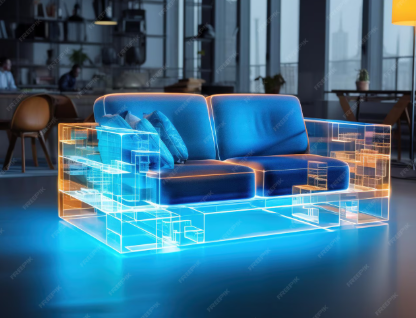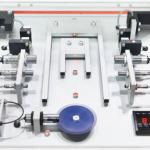In an era where personalization and innovation are reshaping nearly every aspect of how we live, one of the most exciting transformations is happening in the world of furniture. Gone are the days when buying a table or chair meant choosing from a catalog of limited styles and sizes. Thanks to advancements in additive manufacturing, or 3D printing, furniture is being reimagined from the ground up—both literally and creatively. Today, 3D printed furniture is redefining the relationship between form, function, and individuality, and the demand for custom 3D printed furniture is steadily growing as people seek pieces that reflect their unique lifestyles and spaces.
Let’s explore this emerging intersection of design and technology, and why 3D printing might just be the future of how we furnish our homes, offices, and public spaces.
What is 3D Printed Furniture?
At its core, 3D printed furniture is created by layering material—usually plastic, resin, concrete, or even wood-infused composites—according to a digital model. Unlike traditional furniture-making, which often involves cutting, gluing, or assembling separate parts, 3D printing builds a piece from the ground up, layer by layer, in a continuous process.
This approach allows for astonishing flexibility in design. Organic shapes, intricate textures, and futuristic forms that were once difficult or impossible to manufacture with traditional techniques are now not only possible—they’re accessible.
Beyond aesthetics, 3D printed furniture also stands out for its efficiency. It reduces waste by using only the material necessary for the design, and it can drastically cut down on production time, especially when paired with automation and AI-driven design systems.
Why 3D Printed Furniture is Gaining Ground
As 3D printing technology becomes more sophisticated and accessible, furniture designers are increasingly turning to it as a sustainable, flexible, and creative solution. Here are some reasons why this trend is gaining serious momentum:
Sustainable Production
Traditional furniture manufacturing can be resource-intensive, involving large amounts of wood, metal, and fabric—often with a lot of waste. In contrast, 3D printing is an additive process, meaning it only uses the material that’s needed. Many 3D printed pieces are also created using recycled materials, making them an environmentally conscious choice.
Limitless Design Possibilities
With 3D printing, the only real limit is the imagination. Unlike mass-produced furniture that conforms to standard molds or parts, 3D printed furniture can be sculptural, experimental, and even interactive. Whether it’s a coffee table that mimics the movement of waves or a chair inspired by natural coral structures, the possibilities are virtually endless.
Faster Prototyping and Production
Creating a new design from scratch in traditional furniture-making can take weeks or even months. With 3D printing, a digital model can be adjusted and printed in just a few days—sometimes hours—dramatically speeding up the creative and production processes.
Personalization and Customization
Perhaps the biggest appeal of this technology is its potential for customization. That’s where custom 3D printed furniture truly shines.
What Makes Custom 3D Printed Furniture So Special?
The beauty of custom 3D printed furniture lies in its ability to meet the specific needs, tastes, and spaces of individual users. Customization isn’t just about choosing a color or material—it’s about shaping an entire piece around you.
Tailored to Space
Have an oddly shaped corner in your home or an unusually narrow hallway? Traditional furniture may not offer a suitable solution. With custom 3D printed designs, furniture can be scaled and shaped precisely to fit any space, solving practical challenges while enhancing aesthetics.
Designed Around Your Lifestyle
Whether you work from home, entertain often, or need multifunctional pieces in a compact apartment, custom designs can be made to fit how you actually live. Need a table with built-in storage for tech gadgets? Or a standing desk that adjusts to your exact height? 3D printing makes it all possible.
One-of-a-Kind Pieces
In a world full of mass-produced items, owning something truly unique is a luxury. Custom 3D printed furniture offers an opportunity to own a statement piece that no one else has—something designed exclusively with your taste in mind.
Collaborative Design
Thanks to accessible 3D modeling software and design platforms, the process of creating custom furniture is more interactive than ever. You can be part of the design process, adjusting dimensions, choosing patterns, and even collaborating with designers to bring your vision to life.
Materials in 3D Printed Furniture: More Than Just Plastic
While plastic is often associated with 3D printing, today’s 3D printed furniture can be made from a variety of innovative and sustainable materials:
- Bioplastics made from renewable resources like cornstarch
- Concrete blends for robust outdoor seating and benches
- Wood-plastic composites that resemble natural wood
- Recycled polymers, reducing waste and carbon footprint
Each material brings its own benefits in terms of strength, flexibility, and aesthetic appeal. As the industry matures, new eco-friendly and high-performance materials are continually being introduced.
Design Trends in 3D Printed Furniture
The freedom of form offered by 3D printing has inspired a range of design styles, from ultra-minimalist to wildly experimental. Some trending ideas include:
- Parametric designs that adapt shape based on input variables (like room size or user height)
- Organic and biomimetic forms inspired by nature—curves, honeycombs, and cellular structures
- Lightweight lattices that reduce material use while maintaining strength
- Multi-material printing, which combines textures or finishes in one piece
These trends highlight how 3D printed furniture is not just about utility—it’s about artistic expression.
Challenges and the Road Ahead
While the promise of custom 3D printed furniture is immense, it’s not without its challenges. The cost of high-end 3D printers and materials can still be prohibitive for some. Moreover, the durability of certain materials might not yet match traditional furniture, especially for heavy-use items.
That said, ongoing innovation is rapidly addressing these issues. As technology becomes more affordable and materials more advanced, it’s likely that 3D printed furniture will become a mainstream option—especially for people who value design, sustainability, and personalization.
Conclusion: A New Era in Furniture Design
The fusion of technology and design is ushering in a new era for the way we think about furniture. No longer limited by mass production or standard sizes, we now have the tools to create pieces that are tailored to our needs, our tastes, and our values. 3D printed furniture offers a compelling blend of artistry, efficiency, and sustainability, while custom 3D printed furniture takes that vision even further—delivering furniture that’s as unique as the people who use it.
Whether you’re an interior design enthusiast, a sustainability advocate, or someone simply looking for a better fit for your living space, the world of 3D printed furniture opens up a realm of exciting possibilities. And this is just the beginning.


